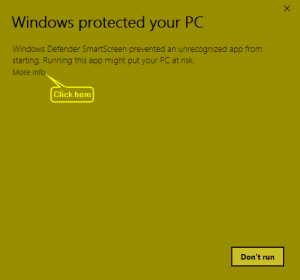KYOSHchat
KYOSHchat Config Tool
The KYOSHchat Config Tool (with Pidgin) will let you:
- create a new account,
- modify the password for a current account, or
- reinstall the chat client (Pidgin).
You can download the newest KYOSHchat Config Tool from here. It doesn't matter where you choose to save it. Just remember where you did so that you can find it to run it. As always, you can use whatever client you'd like once your account is setup.
Once that ZIP file is open, you'll see another file — KYOSHchat_Config_Tool.exe. Double-click on that file. This is where the fun begins. Follow the prompts and let me know if there's anything that goes wrong. Here are some speed bumps you may encounter:
- If you try to open the .exe file in Windows 10, you'll get a notice like what is shown (Image 1). Just click the "More Info" text and then click the "Run Anyway" button.
IMPORTANT: If you're wanting to create an account, you need to be on your work computer and connected to the work network (either in the office or over the VPN). The same applies for modifying your account password. Once you have your account setup, you can connect from anywhere and from any device.
If you're just changing your password but still using Pidgin, make sure you change your password in Pidgin's account settings, as well, following these steps:
- Open up the main Buddy List window
- Click Accounts
- Double-click your @kyoshchat account
- Erase the password that's in the Password field
- Enter the new password you entered in the Config Tool.
- Click the Save button and hit Close.
Spark
Encrypted Communications
All chat messages are encrypted between the client you use (e.g., Spark or Pidgin) and the KYOSHchat server. Eavesdropping is virtually impossible.
However, for those of you who are especially "cautious," there is a protocol called Off-The-Record (OTR) that can be utilized from within Spark. You can have an encryption key setup for each person you chat with.
Think of an OTR encryption key as a secured lock box. You open the lock box and put your message inside of it. You then put it in the mail and send it to another person. When they receive the lock box, they can only open it and read the message if they have an exact copy of the key you used to lock it. Anyone who tried to read the message while in transit between the two could only read it if they had a key copy, as well.
The catch is that you and the other person need to share that key with one another — in a way where the identity of the other person can be authenticated. It would be unwise to send the key with the package or even in an envelope through the mail, which can be easily steamed open, have the key removed, copied, and replaced, and then resealed — having you none the wiser. One way to do this — and the most obvious way — is to share the key in person. Whatever way you want to share a string of text with the other person is a potential route. Just remember that the encryption key is only as good as the medium through which it's being sent.
In addition to being able to have a shared, secret key, you can change to a new key as often as you'd like — even as often as after every conversation with that person.
To enable OTR encryption,
Technical Info
The chat server being used utilizes the XMPP/Jabber protocol. The server is Ignite Realtime's Openfire and is being served from an AWS Ubuntu instance and a Google Cloud Platform Ubuntu instance. This server is not located on KY's network. Your private messages should be encrypted between you and the person with whom you're chatting. The chat server is utilizing an SSL certificate signed by Let's Encrypt.
Because this is an XMPP/Jabber protocol server, you don't have to use Spark or Pidgin! You can use any XMPP client you prefer. I'm providing the customized version here for simplicity's sake. The easier it is for someone to setup and use a program, the more likely they are to actually use it.
That being said, you can even download Pidgin yourself from their site and install their application and set it up exactly the way you want it. Just ask me for the connection details if you can't get them from someone else's connection settings. Below are a few examples of other clients you may want to try. Remember though that, sometimes, there are differences between clients such that, even running on the same protocol, problems may arise. Such issues may keep you from, for example, sending files back and forth. For the most part, however, any modern XMPP clients will play well with others.
- Spark
- Pidgin
- Gajim (another one of my faves)
- Messages (for Apple's iPhone, iPad, and macOS)
- Trillian (they also have an Android app)
- Various Windows, macOS, iOS, and Android apps
- If you're feeling lucky, click here to search Google to find more options.
The Config Tool has undergone a great deal of change. The long and short of it is that the setup file no longer utilizes a key-clicking script to cycle through the client's account creation windows in an attempt to hopefully get everything typed in or selected correctly. I knew from the get-go that it was a temporary measure ... and that it was not exactly neat and tidy. This new method starts from the ground-up using .NET and the chat server's API calls. It's probably not perfect, but it's certainly a lot more tame than the bucking bronco that was the previous script.

